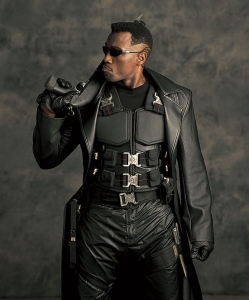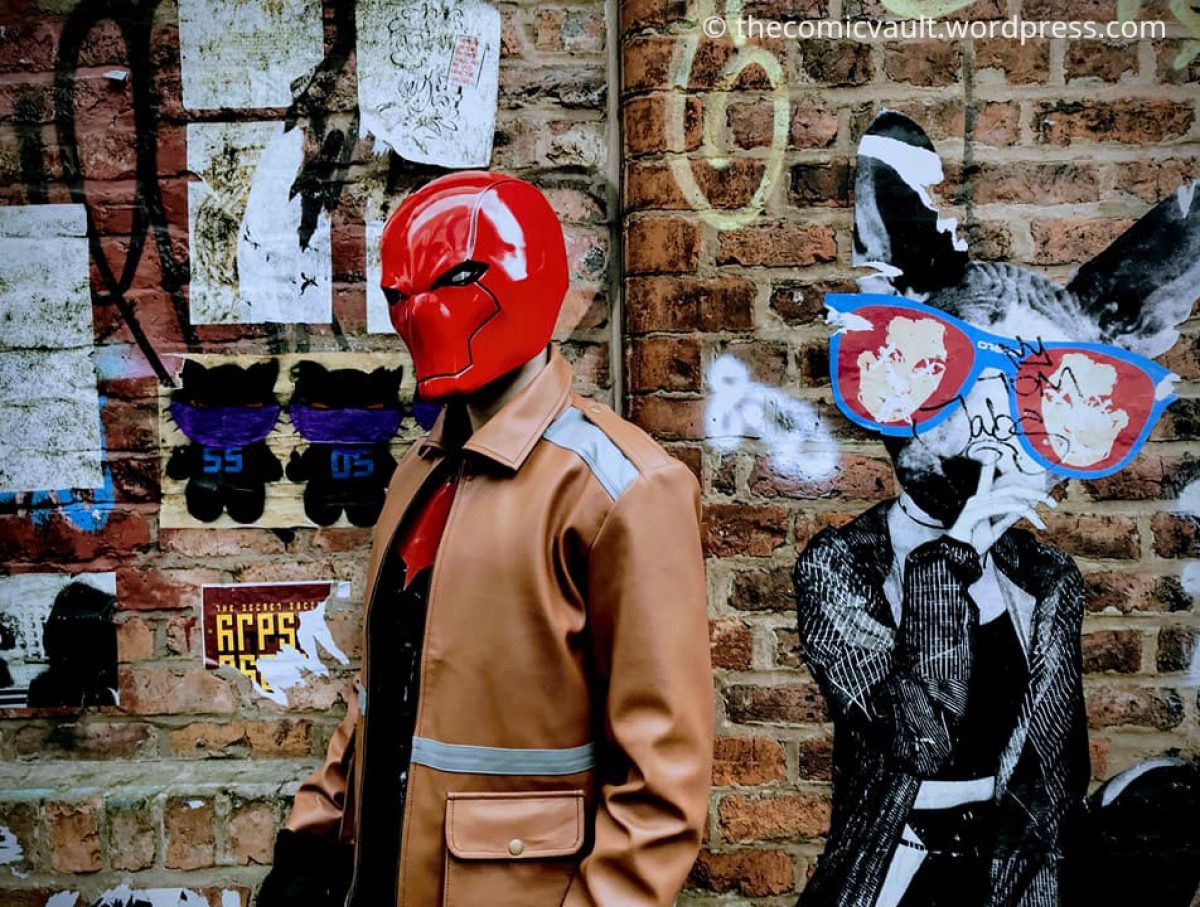The idea of the vampire has developed considerably since the days of Stoker, whether through the medium of television or film. In recent years comics and graphic novels have served as a popular method to introducing the supernatural. One of the most enduring comic vampires is Blade The Vampire Hunter, a character who has transcended into film and TV.
 Blade’s status as a person of colour makes him unique in a world of ruthless blood suckers, as does his nature as a dhampir. As a half vampire, half human hybrid, Blade is able to walk in daylight and suffers from none of the conventional weaknesses of a regular vampire. The character’s origin changed to a dhampir when the first Blade film was released. Originally, Blade was a human who was immune to being turned into a vampire. He didn’t receive any supernatural powers until he was bitten by Morbius, The Living Vampire in Peter Parker: Spider-Man 8 published in 1999.
Blade’s status as a person of colour makes him unique in a world of ruthless blood suckers, as does his nature as a dhampir. As a half vampire, half human hybrid, Blade is able to walk in daylight and suffers from none of the conventional weaknesses of a regular vampire. The character’s origin changed to a dhampir when the first Blade film was released. Originally, Blade was a human who was immune to being turned into a vampire. He didn’t receive any supernatural powers until he was bitten by Morbius, The Living Vampire in Peter Parker: Spider-Man 8 published in 1999.
Born Eric Brooks, Blade was raised in a brothel in the Soho neighbourhood of London in 1929. His mother Tara experienced birth complications and called for a doctor. The doctor happened to be a vampire called Deacon Frost who bit her during Eric’s birth and passed on enzymes in his blood that transferred to the baby.
Blade went on to develop vampire like abilities, being trained as a hunter by a jazz trumpeter named Jamal Afari. Several years later his mentor would be turned into a vampire by Dracula, leading to many confrontations between the two.
The character was first created in 1973 by Marv Wolfman, appearing in Marvel’s The Tomb Of Dracula 10. The comic was drawn by an artist named Gene Colan who said of the creation “Marv told me Blade was a black man…the bandolier of blades – that was Marv’s idea. But I dressed him up. I put the leather jacket on him and so on.” Colan’s inspiration came from a number of black actors and he drew Blade with a 70s style afro and gave him teak bladed knives.
Wolfman admitted that he “wasn’t happy with Blade’s dialogue” at the time so he thought about changing him to be less of a stereotype. “The early Blade dialogue was cliche ‘Marvel Black’ dialogue. Later on I tried to make him more real. But it took to growing up as a writer.”
Blade had his first solo adventure in Vampire Tales 8 published in 1974. His rise to prominence started in the 1990s in Ghost Rider 28, Nightstalkers and Midnight Sons Unlimited. It was during the early 90s that the first Blade film was talked about, with rapper LL Cool J expressing interest in the role. Eventually, the film was set up by New Gate Line Cinema who wanted to do Blade as similar to a spoof. By 1996 Wesley Snipes was picked in the leading role and the character’s origin changed to fit with a 90s audience.
Blade’s origin story may have changed in order to make it more believable to a film audience that a human could successfully hunt and kill supernatural creatures. The idea of a vampire human hybrid is potentially more exciting than a regular human, therefore making someone more likely to watch the film. As the character was also changed from an Englishman to an American this may have been done to achieve wider appeal.
When the film came out in 1998 it was Marvel’s first box office success, arguably creating a future for the likes of the Iron Man and Avengers series.
 In the film series Blade grew up in Detroit, Michigan and the only vampiric weakness he suffers from is blood lust. He held the urge back through taking a serum. Similar to his comic counterpart he is a master martial artist. The Blade film franchise spawned a trilogy with the rights reverting back to Marvel in 2011. In 2013 it was reported that a fourth Blade film is in the works and Snipes is set to reprise his role.
In the film series Blade grew up in Detroit, Michigan and the only vampiric weakness he suffers from is blood lust. He held the urge back through taking a serum. Similar to his comic counterpart he is a master martial artist. The Blade film franchise spawned a trilogy with the rights reverting back to Marvel in 2011. In 2013 it was reported that a fourth Blade film is in the works and Snipes is set to reprise his role.
After the success of the films, a TV series was developed and aired on Spike TV in 2006. The TV adaption of Blade retained most of his characteristics, with slight tweaks to his origin such as his father raising him until he was twelve. As the show was episodic, there was a greater opportunity to flesh Blade out without needing to explain his origin in one sitting.
The character was portrayed by rapper Kirk ‘Sticky Fingaz’ Jones, and although the series was popular it only lasted for one season. The two hour pilot was co-written by comic writer Geoff Johns. He claimed the show was canceled because at the time Spike TV was a young network and they couldn’t afford the production costs.
Blade’s next major TV appearance occurred in 2011 as part of a collaboration between Marvel Entertainment and the Japanese animation studio Madhouse. The character was used in an anime series that ran for twelve episodes. Blade is on a mission in Japan where he confronts Deacon Frost and a vampire organisation known as ‘Existence.’ The series focuses on Blade’s swordsmanship, with his mastery of a technique called Yagu Shinkage-ryu, a style that unleashes powerful shockwaves.
 Recently, there has been a greater focus on Blade returning to comic book prominence. In 2008 he joined the cast of Captain Britain and M113, protecting England from supernatural threats. In 2011 the character featured in the ‘Curse of the Mutants’ storyline, crossing over with the X-Men as vampires attacked and turned mutants. He also appeared as part of the Mighty Avengers team, using the identity of Ronin.
Recently, there has been a greater focus on Blade returning to comic book prominence. In 2008 he joined the cast of Captain Britain and M113, protecting England from supernatural threats. In 2011 the character featured in the ‘Curse of the Mutants’ storyline, crossing over with the X-Men as vampires attacked and turned mutants. He also appeared as part of the Mighty Avengers team, using the identity of Ronin.
Since his creation, Blade has been adapted numerous times and exposed to audiences all over the world. Each interpretation has remained faithful to the core work of Wolfman and Colan. Blade’s influence on vampire literature is undeniable, with him being identified as the most iconic hero to emerge from monster themed comic stories. Blade will continue to be a powerful example of an ethnically diverse character who can save the day and strike fear into creatures of the night.


Cool post 😀 Always nice to read a background story for such a cool comic character. I really enjoyed the tv series, and was always disappointed by the way they left the series with an enormous cliffhanger.
LikeLike
Thanks! And I know what you mean. It was a shame the show was cancelled, but hopefully Blade will be resurrected again soon as Snipes is keen to pick the character back up.
LikeLiked by 1 person
Again, thanks for the background info because I did not know Blade was a comic book figure. I enjoyed the movie with Wesley Snipes but I think I’d prefer the comic book version of a human immune to being turned a vampire. I think that’s far more interesting.
LikeLiked by 1 person
It is fascinating how film studios alter a character based on how they think an audience will react. Snipes was instrumental in bringing Blade into the mainstream. But his comic origins as a prominent black superhero will always be what stands out the most.
LikeLike